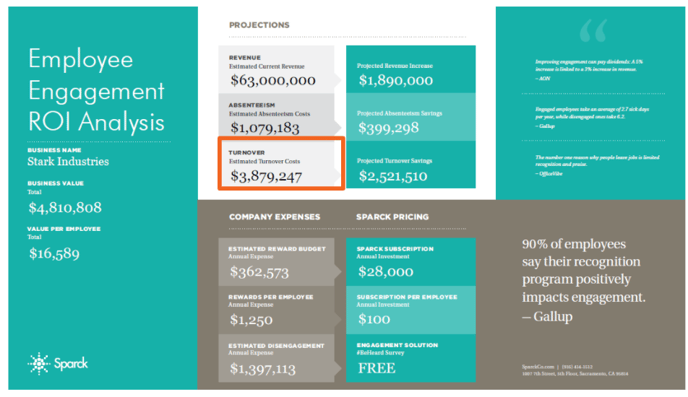Here's a high level overview of how to calculate turnover costs and projected savings for the ROI Analysis.
Turnover is the third section where the R&D division will get the greatest return on their investment. It’s especially intriguing because there’s a tremendous opportunity to increase retention by making engagement a strategy.
It's extremely painful for an organization, mentally and financially, when someone leaves. It takes an average of 42 days to fill a vacant position, and that doesn’t even include the time it takes to get a new employee trained and up to speed. There’s so much time and money that's wasted when losing an employee, and not to mention stress for the team! But here’s the silver lining, and the part that we are excited to share: 65% of employees who quit do so voluntarily!

Companies have a huge opportunity to win back a large majority of the 65% who are voluntarily leaving, changes just need to be made. Most often, great employees leave companies because their needs are not being met...yet!
This presents a targeted engagement opportunity to retain this talent and save money, time, and productivity. When calculating the projected turnover savings, we zeroed in on this opportunity cost to spotlight what is possible with increased engagement.
The Formulas
Though this is a multiple step process, at a high level, we are able to calculate the total turnover costs of $3,879,247 and the projected savings of $2,521,510 using these formulas:
- Estimated Turnover Costs: Average Turnover Cost by Employee x Average Employee Turnover
- Projected Turnover Savings: Total Turnover Costs x 65%
Estimated Turnover Costs
To calculate turnover costs, we need the average salaries, turnover rate, and number of employees. Let's start by uncovering the intangible and tangible costs associated with each employee who leaves.
Gallup has an easy calculation that we use based on multiplying the employee’s salary by a specific percentage tied to their position level. The percentage increases as the position becomes more senior or technical because these employees are more difficult to find and replace.
Here's a breakdown of costs by different position levels on the Reference Page, as noted by the orange box below:
To put this into perspective, if a mid-level employee resigns, you're losing an average of 150% of that employee’s annual salary in lost time and costs. However, if an entry level employee resigns, you're only losing an average of 50% of the annual salary because the candidate pool for entry-level roles is a lot larger.
If there are a lot of technical level employees who are quitting though, even if the turnover rate is only 7.55%, it’s costing you 250% of the annual salary in lost time and costs every time one of these technical employees leave.
Next, we need the turnover rate to first get an idea of how many people are leaving every year. For this example, an annual turnover rate of 7.55% was determined using the Sparck Engagement Calculator.
Let's walk through the calculations and formulas at a high level next.
High Level Overview of Turnover Costs and Savings

Because turnover calculations are more complex than our revenue calculation, we broke it down into three different parts:
Average Turnover Cost by Employee: First, we need to determine the average salary. We an average salary for entry level and an average salary for technical positions, so we need to average turnover costs based on the salary level. Turnover costs entry-level positions 50% of the salary while turnover costs for technical-level positions 250% of the salary. We end up with an average salary of $177,175.
Average Employee Turnover: Next, to determine the turnover cost by employee, you can use a rate you already have or use our Sparck Calculator to determine your company's turnover rate. In this example, the turnover rate we're using is 7.55%. Since we're trying to uncover how many employees are leaving each year, we multiply the turnover rate by the number of employees, which is 290. We end up with the the average employee turnover of 22 employees.
Total Turnover Costs + Projected Savings: Now we need multiply the average salary ($177,175) by the average employee turnover (22) which gives us the total estimated turnover costs of $3,879,247. If 65% of employees are leaving voluntarily, then the projected savings is $2,521,510.
Next Steps:
- Now the turnover calculations are far more complex than our revenue calculation, so to understand where we got the numbers above, we also walk you through the step-by-step calculations of absenteeism costs and projected savings.
- Go back to the ROI Analysis Toolkit to learn more about the different sections of the ROI Analysis.